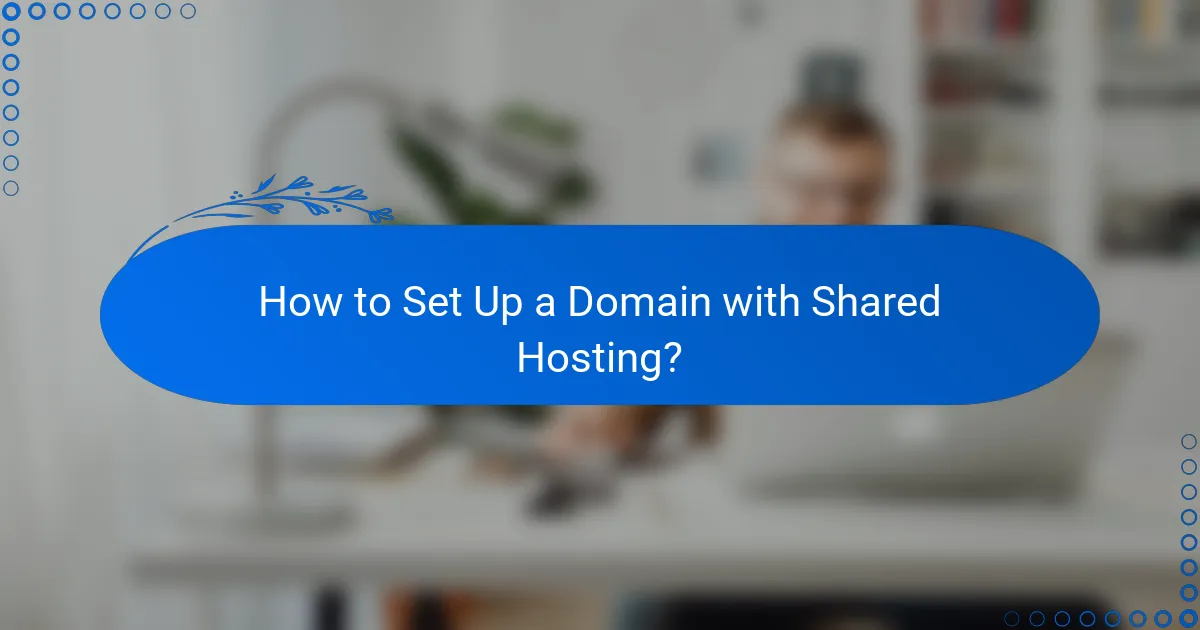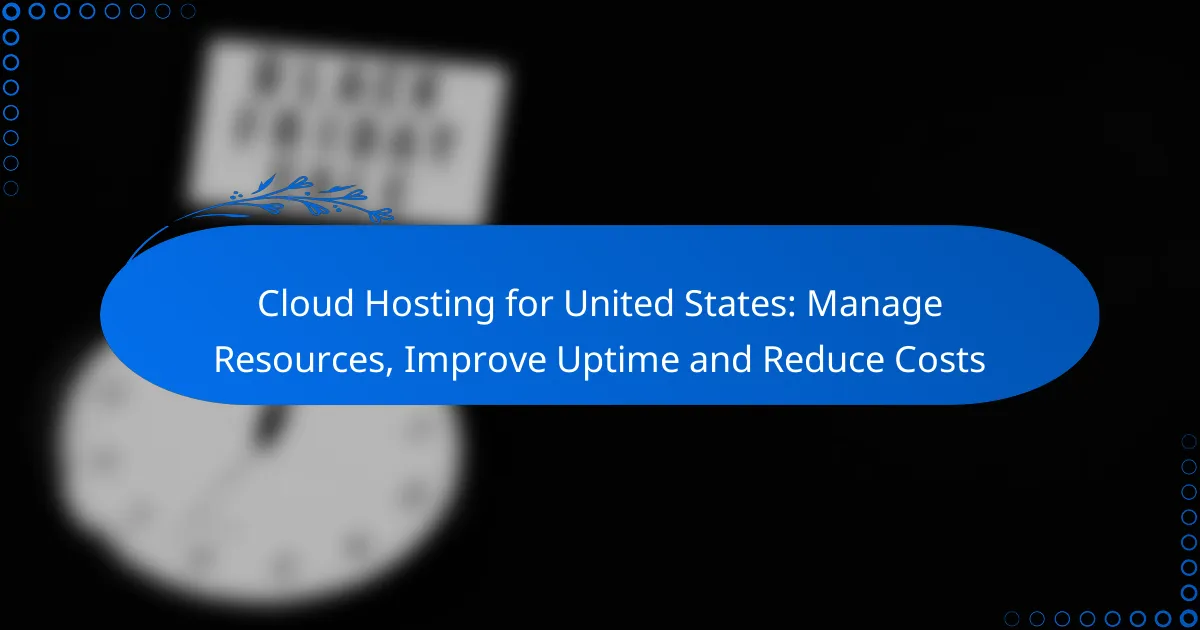Shared hosting in the United States provides affordable options for individuals and small businesses, with plans ranging from $2.95 to $10 per month. Users can easily register domains, choose suitable hosting plans, and install applications like WordPress or Magento with one-click processes. Understanding your website’s needs and future growth potential is essential for selecting the right plan that balances cost and features.

What Are the Best Shared Hosting Plans in the United States?
Shared hosting plans in the United States offer budget-friendly solutions for individuals and small businesses, with prices typically ranging from $2.95 to $10 per month. These plans allow multiple websites to share a single server, significantly reducing costs while providing essential features like storage, bandwidth, and customer support. Choosing the right plan depends on your specific needs, including storage capacity, bandwidth limits, and the level of customer support available.
Many providers attract new customers with introductory pricing, often as low as $2.75 per month for the first term. However, it’s essential to examine renewal rates, which can rise sharply after the initial period—sometimes by 50% or more. User reviews can also provide insights into the reliability and performance of each hosting option, aiding in your decision-making process.
Ultimately, the best shared hosting plan balances cost, features, and customer service, ensuring you get the most value for your investment. Here are some top providers to consider for your hosting needs.
Bluehost Shared Hosting Plans
Bluehost shines with its user-friendly interface and comprehensive features, making it a leading choice among shared hosting providers. Their plans typically include a free domain for the first year, an SSL certificate for enhanced security, and 24/7 customer support, making it ideal for beginners looking to establish an online presence.
Bluehost offers three main shared hosting tiers: Basic, Plus, and Choice Plus, with prices starting at $2.95 per month. Each tier provides varying levels of storage and bandwidth, allowing users to choose a plan that suits their needs. For example, the Basic plan is perfect for a single website, while the Plus plan supports unlimited websites, catering to growing businesses.
Moreover, Bluehost integrates seamlessly with WordPress, a significant advantage for bloggers and small business owners. Their commitment to uptime, averaging 99.9%, ensures your website remains accessible to visitors, enhancing user experience and engagement.
HostGator Shared Hosting Plans
HostGator is another leading provider of shared hosting in the United States, offering flexible plans tailored to diverse needs. Their Hatchling, Baby, and Business plans provide a variety of options for individuals and small businesses, with prices starting around $2.75 per month. Each plan includes a free website builder, simplifying the creation of a professional-looking site.
HostGator’s plans feature unmetered bandwidth and a 99.9% uptime guarantee, essential for maintaining website accessibility and performance. Additionally, they offer a 45-day money-back guarantee, allowing users to test the service without financial risk, which is particularly appealing for newcomers.
With a focus on scalability, HostGator enables users to upgrade their plans as their websites grow, accommodating those who anticipate increased traffic or require additional features in the future. This flexibility makes HostGator a practical choice for expanding businesses.
SiteGround Shared Hosting Plans
SiteGround is renowned for its exceptional customer service and high-performance hosting solutions, with shared hosting plans built on Google Cloud infrastructure, ensuring fast loading times and reliable uptime. Their offerings include three main tiers: StartUp, GrowBig, and GoGeek, each designed for different user requirements, with prices starting at $3.99 per month.
The StartUp plan is ideal for beginners, supporting one website with essential features, while the GrowBig plan allows for unlimited websites and includes enhanced performance features, making it suitable for growing businesses. The GoGeek plan caters to developers with advanced tools and priority support, ensuring that technical needs are met efficiently.
SiteGround also prioritizes security, providing daily backups and free SSL certificates with all plans, crucial for protecting sensitive data. This emphasis on security and performance positions SiteGround as a top choice for those who value website reliability and user trust.
DreamHost Shared Hosting Plans
DreamHost takes a straightforward approach to shared hosting with its Shared Starter and Shared Unlimited plans, both of which come with a free domain, unlimited traffic, and a generous 97-day money-back guarantee, allowing users to start without a long-term commitment. Pricing for these plans begins at $2.59 per month, making it an attractive option for budget-conscious users.
The Shared Starter plan is designed for single website hosting, while the Shared Unlimited plan accommodates multiple websites and additional features, providing flexibility as your online presence grows. DreamHost also offers a user-friendly control panel, simplifying the management of your hosting account and enhancing user experience.
With a strong focus on privacy, DreamHost includes free WHOIS privacy protection, ensuring your personal information remains confidential. Their commitment to customer satisfaction and transparency makes them a reliable choice for shared hosting, appealing to users who value both performance and privacy.
InMotion Hosting Shared Plans
InMotion Hosting is recognized for its reliable shared hosting plans that cater to both beginners and experienced users, with options including the Launch, Power, and Pro plans, starting at $2.49 per month. Each plan offers a range of features such as free website migration and SSD storage for improved performance, making them suitable for various user needs.
The Launch plan is perfect for new websites, while the Power plan supports multiple websites and provides additional resources, making it ideal for growing businesses. The Pro plan is tailored for businesses requiring advanced features and priority support, ensuring that all technical needs are met efficiently.
InMotion Hosting also offers a 90-day money-back guarantee, allowing users to test their services without risk, which is particularly appealing for those new to web hosting. Their commitment to performance and customer support positions them as a strong contender in the shared hosting market, attracting a wide range of users seeking reliable hosting solutions.

How to Choose the Right Shared Hosting Plan?
Choosing the right shared hosting plan is vital for your website’s performance and reliability. A suitable plan can enhance user experience and boost search engine rankings; studies show that a 1-second delay in page load time can reduce conversions by 7%. Assess your website’s needs, including traffic expectations and resource requirements, which can vary significantly based on your content type.
Start by defining the primary purpose of your website. Is it a blog, an online store, or a portfolio? E-commerce sites, for example, typically demand more resources, such as higher bandwidth and enhanced security features, compared to personal blogs. Each website type requires different resources, influencing your hosting plan choice.
Consider future growth as well. Selecting a plan that allows for easy upgrades can save you time and hassle later. A flexible hosting plan can accommodate increased traffic or additional features, ensuring your website remains functional as your audience expands. This adaptability is crucial for thriving in a dynamic online landscape.
Lastly, read reviews and testimonials from other users. Real-world experiences provide insights into the reliability and performance of various hosting providers, with platforms like Trustpilot and G2 offering valuable user feedback. This information can guide you in choosing a provider that aligns with your specific needs.
Assessing Performance and Speed
Performance and speed are critical in shared hosting. A slow website can lead to high bounce rates—up to 40% of visitors abandon a site that takes more than 3 seconds to load—and lower search rankings. Seek hosting providers that guarantee solid uptime, ideally above 99.9%, to keep your site accessible to users at all times.
Look for features like SSD storage, which can enhance loading times by up to 300% compared to traditional HDD storage. Additionally, consider server locations; servers closer to your target audience can significantly reduce latency, improving overall user experience and engagement.
Utilize tools like Google PageSpeed Insights to assess the performance of potential hosting providers. This will help you make an informed decision based on speed metrics and optimization suggestions, ensuring your website is not only fast but also optimized for search engines.
Evaluating Customer Support
Reliable customer support is essential for quick issue resolution. Seek hosting providers that offer 24/7 support through various channels, such as live chat, phone, and email. Prompt assistance can minimize downtime, which costs businesses an average of $5,600 per minute, keeping your website running smoothly.
Research the reputation of the support team by reading user reviews and testimonials. A knowledgeable and responsive support staff can greatly enhance your hosting experience, with many users valuing quick resolution times and effective communication. This can significantly boost your overall satisfaction with the hosting service.
Additionally, check if the provider offers a knowledge base or tutorials. These resources empower you to troubleshoot common issues independently, saving you time and frustration while enhancing your technical skills as a website owner.
Comparing Pricing and Features
Pricing is a key factor when selecting a shared hosting plan. While it’s tempting to choose the cheapest option, ensure that the features align with your website’s needs. Look for plans that strike a balance between cost and essential features, with many reputable providers offering plans ranging from $2.75 to $10 per month, depending on included resources.
Common features to compare include storage space, bandwidth, and the number of websites allowed. Some providers may offer unlimited resources, while others impose strict limits that could impact your site’s performance. Understanding these differences can help you avoid unexpected costs or performance issues later on.
Also, consider any additional costs, such as domain registration, SSL certificates, and backup services. A low initial price may lead to higher long-term expenses if essential features are not included, making it crucial to assess the total cost of ownership for your hosting plan.

How to Set Up a Domain with Shared Hosting?
Registering a new domain is the first step in building your online presence, with over 360 million domains registered globally as of 2023. Choose a domain name that reflects your brand and resonates with your target audience. Popular registrars like GoDaddy, Namecheap, and Google Domains offer various pricing and features to meet diverse needs.
Registering a New Domain
To register, visit a registrar’s website, search for your desired domain name, and follow the prompts to complete the process. Aim for a name that is memorable and relevant to your content, ideally under 15 characters for easy recall. Once registered, your domain is yours for a specified period, usually one year, with the option to renew. This ownership is vital for branding and online identity, as 77% of consumers are more likely to trust a business with a professional domain.
Transferring an Existing Domain
Transferring an existing domain allows you to move it between registrars, helping you consolidate or take advantage of better pricing and features. Many businesses save up to 30% on renewal fees by switching registrars.
Configuring Domain Settings
To initiate a transfer, unlock your domain at the current registrar and obtain an authorization code. This code serves as a security measure, ensuring that only you can authorize the transfer. Provide this code to your new registrar during the process. Keep in mind that transfers can take several days to complete, and your domain must be at least 60 days old to be eligible. Ensure your domain’s DNS settings are configured correctly to avoid downtime, as even a few hours can lead to significant traffic loss.

What Applications Can Be Installed on Shared Hosting?
Shared hosting allows users to easily install a range of applications that enhance website functionality. Popular choices include content management systems (CMS) like WordPress, Joomla, and Drupal, along with e-commerce platforms such as Magento and WooCommerce. These tools streamline the website creation and management process, accommodating users with varying technical skills.
Installing applications on shared hosting is typically a straightforward one-click process, often provided by hosting companies. This feature is particularly advantageous for beginners, enabling them to quickly set up their websites without extensive technical knowledge. In fact, over 70% of shared hosting providers offer this feature, making it a standard in the industry.
Selecting the right application can significantly impact website performance and user experience. When choosing an application, factors like scalability, ease of use, and available support should be carefully considered. For instance, a CMS that accommodates a growing user base is crucial for businesses expecting rapid expansion.
Some hosting providers offer pre-installed applications, saving users time and effort. Exploring these options can help identify the best fit for specific needs, ensuring a smoother start to their online presence.
WordPress Installation
WordPress is the most popular CMS worldwide, featuring a user-friendly interface and a vast plugin ecosystem with over 58,000 plugins. Installing WordPress on shared hosting is usually simple, often requiring just a few clicks through the hosting control panel. This accessibility has led to WordPress powering over 40% of all websites on the internet.
After installation, users can choose from thousands of themes and plugins to customize their sites, allowing for the creation of everything from basic blogs to sophisticated e-commerce platforms. This flexibility is a key reason WordPress remains a top choice for both novice and seasoned web developers.
WordPress’s extensive community offers abundant resources, including tutorials and forums, making troubleshooting and learning easier for users. This support network is invaluable for those new to website management, helping them navigate challenges effectively.
Joomla Installation
Joomla is a robust CMS that offers more complexity than WordPress, making it suitable for users with some technical knowledge. The installation process is similar, typically facilitated by the hosting provider’s one-click installer. Joomla powers about 2.5% of all websites, highlighting its niche appeal.
Joomla excels in creating social networking sites and e-commerce platforms due to its powerful features and flexibility. Users can utilize various extensions to enhance functionality, allowing tailored solutions that meet specific business needs.
While Joomla has a steeper learning curve, its capabilities make it an attractive choice for users aiming to build more intricate websites. Comprehensive documentation and community support are readily available, helping users navigate the platform and optimize site performance.
Drupal Installation
Drupal is known for its flexibility and power, making it ideal for developers and advanced users. Its installation on shared hosting can be more complex than that of WordPress or Joomla, often requiring manual setup. Drupal is used by approximately 1.5% of all websites, particularly favored by large organizations and government entities for its robust security features.
Renowned for its scalability and security, Drupal allows extensive site customization, tailoring features to meet specific needs. This level of customization is especially beneficial for businesses with unique requirements or those anticipating significant growth.
Although the learning curve can be steep, the rewards include a highly customizable and secure website. Users should leverage Drupal’s extensive documentation and community forums for guidance during installation, ensuring they can fully harness the platform’s potential.

What Are the Key Features of Shared Hosting?
Shared hosting is a cost-effective solution for individuals and small businesses, making it an appealing choice for those launching their online presence. This hosting type enables multiple users to host their websites on a single server, efficiently sharing resources like storage and bandwidth, which can significantly lower costs compared to dedicated hosting options.
Typically, shared hosting plans come with limited storage and bandwidth, ranging from 2 GB to 100 GB of storage and bandwidth limits from 10 GB to 500 GB per month. These specifications make shared hosting ideal for low-traffic websites, such as personal blogs or small business sites. Users can choose from various plans tailored to their needs and budget, ensuring they find the perfect fit for their online endeavors.
Common features of shared hosting plans include email accounts, user-friendly website builders, and one-click app installations, simplifying the website creation process. Understanding these features is crucial for users to select the best plan that aligns with their technical skills and website goals, paving the way for a successful online venture.
Moreover, shared hosting is particularly beneficial for beginners due to its intuitive interfaces and robust customer support, often available 24/7. This accessibility empowers individuals to launch their websites and fosters a thriving online community, encouraging more people to establish a digital footprint.
Storage and Bandwidth Limits
Storage refers to the amount of data you can keep on the server, while bandwidth indicates the volume of data that can flow to and from your website. Shared hosting plans usually offer limited storage, ranging from as little as 1 GB to over 200 GB, depending on the provider and plan chosen.
For example, a basic shared hosting plan might provide around 10 GB of storage, generally sufficient for small websites or personal blogs. However, as your site grows and attracts more visitors, you may need to upgrade to a plan that offers increased storage and bandwidth to accommodate rising traffic and content demands.
Bandwidth limits can vary significantly between plans, with some offering around 100 GB per month while others provide unlimited bandwidth. Choosing a plan with adequate bandwidth is essential to ensure your website remains accessible and performs optimally during traffic spikes, especially during promotional events or product launches.



